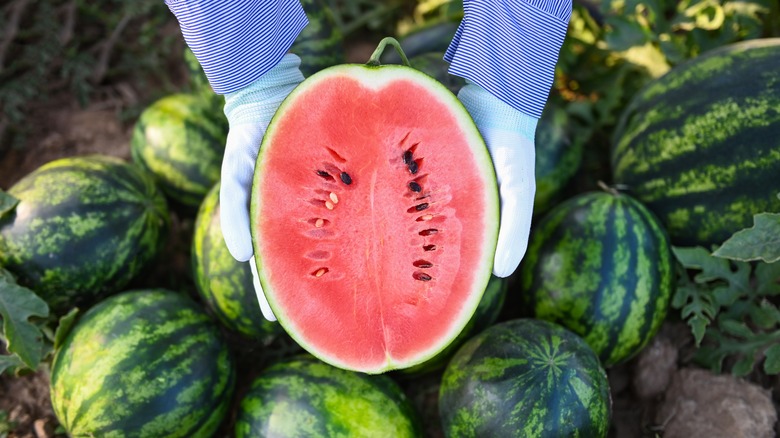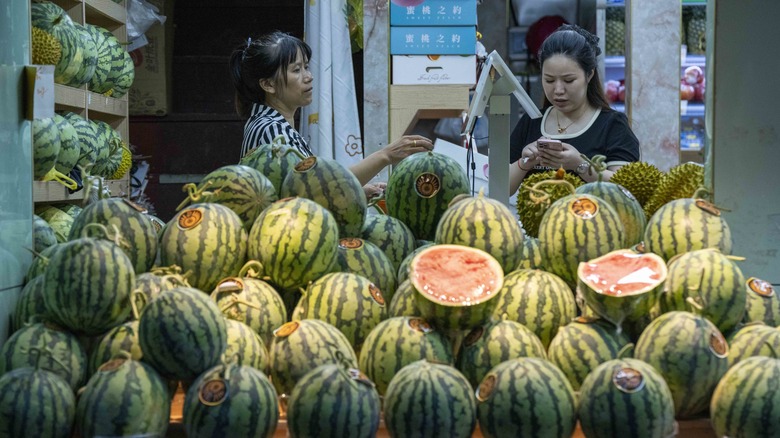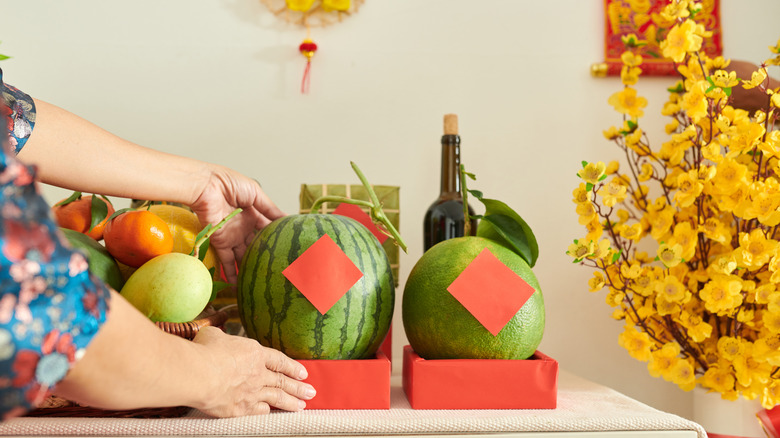The Country That Produces The Most Watermelon In The World
There are many important facts about watermelon, including this one: It is by far the most popular melon in the United States. In 2021, the country grew 1.7 million tons of the fruit. Compared to 75,000 tons of cantaloupe grown in the U.S. over the same time, it's pretty impressive.
However, compared to the world's leading watermelon producer, the U.S. is merely a drop in the bucket. China is a watermelon powerhouse, producing 67.2 million tons of the fruit in 2021. And no other country can even get close; the nearest competitor is Turkey with an approximate 3.9 million tons grown in the same time span.
While the melon is harvested throughout China, a lot of watermelon farming is attributed to the Gansu province in the north-central region of the country. Gansu's climate seems tailor-made for growing melons of all kinds as it gets a massive amount of sun and the temperature averages around 53-61 degrees Fahrenheit. While the region is quite arid, farmers have developed planting and irrigation techniques that are conducive to excellent watermelon growth. And they aren't just producing high-quality fruit: The environmental conditions also create excellent seeds for further growth in other locations.
China is also the leading watermelon consumer
Since China is churning out literal tons of watermelon each year, it might make sense that residents are consuming quite a lot of the fruit (adding to the fact is that China is also the second most populous country in the world with 1.4 billion people). In 2020, China's per capita consumption was 108 pounds. And with the average weight of each fruit topping anywhere from 20-25 pounds, that means each person ate four to five whole watermelons in one calendar year.
Also no surprise: Other countries can't hold a candle to China in this category, either. China's closest competitor in watermelon production, Turkey, clocks in at 48 pounds per person. In 2021, the United States had a per person consumption of 14.4 pounds, which is less than one watermelon a year. And Japan, a country that specializes in expensive square-shaped watermelons, they average just eight pounds per person.
Based on numbers alone, it's clear that China is the watermelon capital of the world. But there's also a cultural connection to the fruit that goes beyond simple math.
Watermelon is a significant part of Chinese culture
Watermelons are native to South Africa and were transported to China sometime in the 10th century AD. They started as a food reserved only for the rich and their manufactured scarcity made them a prized object for anyone who could get their hands on one. This trend persisted for centuries and the watermelon was ingrained into Chinese culture as an exotic, luxurious fruit. Even now, as its proliferation in China has made it much easier to obtain, the fruit still carries some cultural cache.
Intertwined with this history are several Chinese customs. When visiting a home in China, it is customary to bring a gift for the hosts. Watermelon has been a very popular choice, in part due to its prior status as an aristocratic food. The multitude of seeds, the round shape, and the red interior all bear significance in Chinese culture as well; they have come to represent prosperity and luck. This also makes the watermelon a popular inclusion in any Lunar New Year celebration.
Eating a watermelon on its own is a popular way to beat the summer heat in China, but the fruit has also been infused into Chinese cuisine in other ways. Watermelon chicken utilizes a hallowed out rind as a serving bowl for the soup. Xi gua lao is a popular Beijing jelly dessert made from watermelon and cherry, and the rind is even used in a variety of stir-fry dishes.



